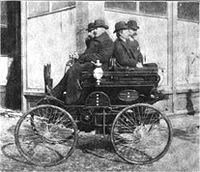Encyclopedia Dubuque
"Encyclopedia Dubuque is the online authority for all things Dubuque, written by the people who know the city best.”
Marshall Cohen—researcher and producer, CNN
Affiliated with the Local History Network of the State Historical Society of Iowa, and the Iowa Museum Association.
AUTOMOBILES: Difference between revisions
No edit summary |
No edit summary |
||
| Line 2: | Line 2: | ||
In the early years, automobile ownership in Dubuque was often limited to those who already owned an auto and used new examples to replace their older models. Many of these people also belonged to the [[DUBUQUE AUTOMOBILE CLUB]]. Popularity of automobiles for a wider audience of people began in 1906 after cars had been proven both dependable and fashionable. | In the early years, automobile ownership in Dubuque was often limited to those who already owned an auto and used new examples to replace their older models. Many of these people also belonged to the [[DUBUQUE AUTOMOBILE CLUB]]. Popularity of automobiles for a wider audience of people began in 1906 after cars had been proven both dependable and fashionable. | ||
By 1918 automobiles had become more than a novelty. State and local laws were passed that were often ignored. In response, the police department in Dubuque in July, 1918 announced that it would begin an active program to arrest "autoists." On July 12, 1918, owners of automobiles were given five days to obtain the necessary equipment for their cars. Chief of Police J. W. Giellis announced that the city and county attorneys would assist in the prosecution of all violators and that no excuses for non-compliance would be allowed. (1) | |||
Many problems facing law enforcement. Automobile owners often operated their cars without license plates, only one license plate, with paper license plates, or using the dealer's number without actually applying for a set of plates. Other drivers operated cars at night without tail lights or with only one headlight. Glaring or blinding lights were also cited as violations of traffic laws. (2) | |||
--- | |||
1. "Police Ready to Arrest Autoists," Telegraph Herald, July 12, 1918, p. 2 | |||
2. Ibid. | |||
See: [[ADAMS-FARWELL AUTOMOBILES]] | See: [[ADAMS-FARWELL AUTOMOBILES]] | ||
[[Category: Industry]] | [[Category: Industry]] | ||
Revision as of 20:00, 27 August 2014
AUTOMOBILES (first). The first automobile to be introduced to the citizens of Dubuque was owned by F. O. FARWELL. An electric runabout of questionable ability, the car was brought to Dubuque in 1900. Within months Charles Gordon, a builder of internal combustion marine engines, purchased a Haynes-Apperson, the first gasoline-powered auto to be seen in Dubuque. Two years passed before Charles Tibbals purchased an Oldsmobile from an out-of-town dealer. Another Oldsmobile was bought by Gordon who used it to replace his Haynes-Apperson. H. G. Boldt's 1903 Cadillac was later used by the Boldt Company as a delivery car.
In the early years, automobile ownership in Dubuque was often limited to those who already owned an auto and used new examples to replace their older models. Many of these people also belonged to the DUBUQUE AUTOMOBILE CLUB. Popularity of automobiles for a wider audience of people began in 1906 after cars had been proven both dependable and fashionable.
By 1918 automobiles had become more than a novelty. State and local laws were passed that were often ignored. In response, the police department in Dubuque in July, 1918 announced that it would begin an active program to arrest "autoists." On July 12, 1918, owners of automobiles were given five days to obtain the necessary equipment for their cars. Chief of Police J. W. Giellis announced that the city and county attorneys would assist in the prosecution of all violators and that no excuses for non-compliance would be allowed. (1)
Many problems facing law enforcement. Automobile owners often operated their cars without license plates, only one license plate, with paper license plates, or using the dealer's number without actually applying for a set of plates. Other drivers operated cars at night without tail lights or with only one headlight. Glaring or blinding lights were also cited as violations of traffic laws. (2)
---
1. "Police Ready to Arrest Autoists," Telegraph Herald, July 12, 1918, p. 2
2. Ibid.


